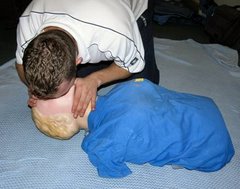First Aid Regulations
One of the main concerns that people express on my first aid courses is the fear of litigation if they carry out their first aid wrongly in the heat of an emergency situation. Some of my students have even expressed their intention to turn a 'blind eye' to an injured person in the street for fear of being accused of some sort of wrong doing. Very sad but a true indication of the nauseating 'ambulance chasing' culture that is now rife in the UK. Luckily, in English law (until Europe declare otherwise), there is the concept of a 'reasonable man' who performs reasonable actions in a given situation. First aid falls into this category - if you are treating someone sensibly, in the manner you honestly believe is best for them at the time, you should be okay.
In the workplace and at mass gatherings there is specific legislation that governs the first aid provision required. The first aid training providers are also closely monitored to ensure they deliver a consistent, high level of accurate training across the board.
Workplace:
The Health and Safety (First Aid) Regulations 1981 place a duty on employers to make first aid
provision for their employees in case of illness or injury in the workplace. The Health and Safety Executive provide an Approved Code of Practice (ACOP) in relation to workplace first aid. The number of first aiders in a workplace is determined by a local risk assessment of the buildings and facilities. Every workplace is required to maintain a book recording the details of accidents (incident book). The following details are to be entered in to the incident book:
- Full name and address of the casualty.
- The casualty's occupation.
- Date that the entry was made.
- Date and time of the incident.
- Place and circumstances of the incident.
- Details of any injuries sustained and treatment given.
- The signature of the person making the entry.
As a result of the Hillsborough football ground disaster in 1989, when 96 football fans were crushed to death, new rules were implemented governing the provision of first aid at mass gatherings. The minimum requirements are:
- One trained first aider for every 1000 people in attendance.
- An approved and designated first aid room.
- A doctor for events with more than 2000 in attendance.
- A fully equipped ambulance, approved by one of the Voluntary Aid Societies or local NHS ambulance service, for events with more than 5000 in attendance.
Training and certification:
Certificated first aid training must be carried out be either:
- One of the Voluntary Aid Societies (St. John Ambulance, St. Andrew's Ambulance, the British Red Cross or the Order of Malta).
- A private company that is registered and approved by the Health and Safety Executive (HSE). That company should display their HSE registration number clearly on any certificate they issue.
- The National Health Service.
There are four common types of first aid course on offer:
- Basic First Aid (usually about 8 hours of training)
- First Aid at Work (usually 36 hours of training)
- First Aid at Work Requalification (usually 18 hours of training)
- Appointed Person (usually about 4 hours of training)
First Aid trainers, like me, are people who have held the FAW for several years, have teaching experience or qualifications (in my case I am an NVQ trainer and assessor) and are kept up to date with the latest first aid developments. Quite a lot of first aid trainers have other first aid related qualifications - I am trained at automated external defibrillation (AED). We also have to keep an up to date portfolio of our experience and undergo regular reassessment.



